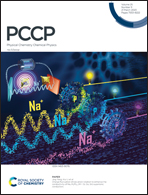Cu–N4 in copper phthalocyanine@CFC catalyst for ammonia oxidation reaction catalysis†
Abstract
The high oxidation overpotential in the ammonia oxidation reaction (AOR) is a key factor restricting the fields of ammonia fuel cells, hydrogen production by electrochemical decomposition of ammonia, and treatment of ammonia-containing wastewater. Copper-based catalysts have been considered hopeless for AOR; however, in this research, copper phthalocyanine (CuPc) catalysts grown on carbon fiber cloth (CFC), CuPc@CFC, were investigated firstly for AOR catalysis, and the unique Cu–N4 resulted in a peak potential of −0.29 V vs. Hg/HgO for AOR, which is superior to Pt/C. Density functional theory (DFT) calculations show that Cu–N4 is the reactive center of AOR, and the LUMO of CuPc is distributed on the Cu site, which is favorable to gain electrons from NH3 and thus adsorb NH3; in contrast, the HOMO of C10H10CuN8 is distributed on the Cu site, which tends to give electrons and is unfavorable to NH3 adsorption. However, copper azide pyridine (C10H10CuN8) was found in the samples after the AOR. Analysis of the comparison samples showed that changing the ethanol content has the effect of changing the grain size and inhibiting the generation of C10H10CuN8 after the AOR process, as well as slightly changing the Cu–N4, leading to the change of its Fermi energy level and d-orbital energy level center, thus providing new ideas for the future fabrication of catalysts in various fields of AOR.



 Please wait while we load your content...
Please wait while we load your content...